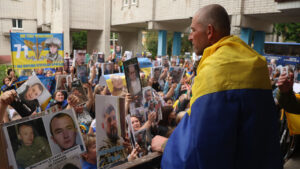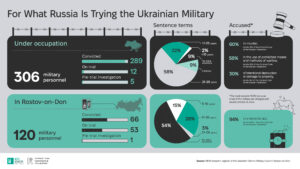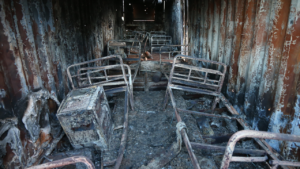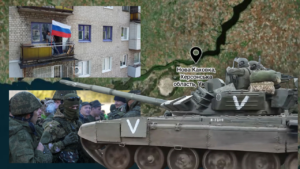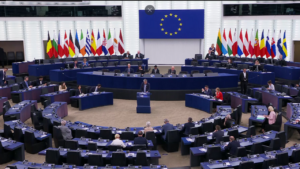“Currency” for Wagner: where did the fighters from the 58th Brigade go?

Since the beginning of Russia’s full-scale invasion of Ukraine, there have been several dozen prisoner-of-war exchanges. Among those released were fighters from the 58th Separate Motorized Infantry Brigade named after Hetman Ivan Vyhovsky. Some of them were considered prisoners of war, and others were missing. In any case, the fate of most of the men who disappeared on the battlefield of this unit is unknown. According to family estimates, there are about three thousand of them. In conversations with the MIPL, some suggest that the soldiers are in detention centers in the occupation, on the territory of the Russian Federation, and in captivity with the Wagner Group.
Iryna has been waiting for news of her husband for over a year. Like other family members, she asked not to be named for security reasons. According to the woman, from the beginning of the full-scale invasion, her husband enlisted in the Kyiv training center, and at the end of May 2022, he was assigned to the 58th Brigade. Soon after, Iryna’s husband went missing with his comrade-in-arms at one of the positions near the village of Pokrovske, Donetsk region, in the Bakhmut direction.
“They were moved to the position at ground zero as if to change the guard. After that, the artillery began to cover them from all sides. Air bombs were dropped on them. More guys were sent there the next day from another company, also assigned to the 58th Brigade. Some of that group also went missing,” says Iryna.
She claims that 11 members of the terrorist defense went missing from those positions. The search for them continues to this day.
The relatives of the missing found out that the 58th Brigade was fighting against the Wagner Group at the time, so relatives assumed that the Wagner Group captured fighters.
“The worst thing for relatives is when no one says anything. Knowing where your loved one is is at least some hope. That’s why every family is trying to find at least something,” says Natalia, the mother of another prisoner. Her son went missing in September 2022 after a battle, also in the Bakhmut sector. Unlike Iryna, Natalia knows for sure that her son was with the Wagner members — a soldier who was released from captivity in December 2022 told her about it.
“That’s it, guys. It’s over. There are only two of you left.”
Ivan Dovhan, a soldier of the 58th Brigade, was captured near Zaitseve, Donetsk region (a settlement 20 km from Bakhmut).
“There were about ten of us. The distance to the enemies was as short as possible. We even echoed with them. I saw their faces. In that battle, I found out later that they lost more than fifty of their fighters. It was a great result for us. There were many more of them, but we did not retreat a single step,” the man says.
After the last attack, he says, there was nowhere to retreat — the enemy surrounded them.
“When the Russian got to us, he said: “That’s it, guys. It’s over. Only two of you left.” That is, they knew how many of us there were and were counting how many were left. And then the Russians said they were from Wagner,” the fighter recalls.
According to the soldier, most of the Wagner members he saw at the time were wearing Ukrainian-style uniforms and civilian pants.
“They made me take off my clothes right there at the position. One of the Wagnerites immediately put on my uniform,” says Ivan Dovhan. “They had colored plastic bracelets on their hands and white bandages on their legs.
The captured Ukrainian was taken to the headquarters, where he was interrogated and beaten. During the interrogation, a Wagner soldier called “Dykyi” broke Dovhan’s legs with a wooden bat.
“His first question was: “Do you know where you are?” I said: “No.” He said, “You are in Wagner. He said that if we behave normally, we’ll get to the exchange: “You are currency for us.”
He emphasized that when we are exchanged, we should not hide it, but tell everyone that we were at Wagner,” says the former prisoner of war.
Another soldier from the 58th Brigade, Oleksandr Koval, was taken prisoner in November 2022. Two days earlier, he and a small group of his comrades had taken defensive positions near Bakhmut. In the evening, the enemy launched an attack.
“We repelled them well,” Oleksandr recalls, “Then their subversive reconnaissance groups crawled all night, about 50-70 meters away from us. They were shooting from machine guns to make us open up, and then they could hit us with artillery. But we were silent, so they finally got tired of it and fired at us with grenade launchers and mortars from midnight to morning.”

Illustrative photo. Photo by AFP
The next day, the enemy attacks continued. Several Ukrainian soldiers were wounded, and several were killed.
“One attack, another. We fought back. Mortar gunners covered us. And then they went on the offensive: no mortars, no grenade launchers, just assault rifles. There were a lot of them. You put them down, and they kept coming,” Koval says.
Ukrainian soldiers fought to the last bullet. At night, the enemy threw gas grenades at their dugouts.
Oleksandr Koval was wounded and deafened. He stayed in the trench for several hours. He came to in the morning when he felt someone tapping his leg. Two men in camouflage uniforms with no logo stood in front of him. At first, Oleksandr thought it was an evacuation, but the assault rifles in the men’s hands made it clear that he was facing the enemy. Later, he found out that he had fallen into the hands of the Wagner Group.
“The sun was warm, the mud was sticking to my boots, my eyes were blindfolded, I couldn’t breathe, they were dragging me. I could not walk. On the way, they threatened to shoot me several times. We passed several of their positions.
On the last one, on a pile of construction waste, I saw two severed heads of our fighters mounted on rebar. “These are Valera and Edik,” they said. They wanted everything to be according to the Geneva Conventions. Do you want that too?” Oleksandr shares his memories.
Then, he was “packed” for delivery to Wagner’s headquarters.
“Packing” is a painful and cruel procedure: a person is forced to hold his hands along the seams, and his torso and legs are taped from the top to the knees so that he can move independently. “They tie me up like in a cocoon, cutting off the blood supply to my arms and back. It was unbearable pain. I thought they would cut off my hands, too,” Koval says.
“The Wagner members threw him into the back of a car and beat him on the way to the headquarters. Upon arrival, they staged a pseudo-execution. “It was a game they played,” the soldier explains. “They blindfolded me and turned to me: “Sanya, why did you betray your homeland? You think you are a prisoner of war. No, you are in the SSU (Security Service of Ukraine)”. I was listening to this conversation and realized from the accent that Russians were talking to me. And then I heard the gun’s bolt being pulled and a shot above my head.”
Oleksandr survived the attack. He assumes that the reason was money: “I guess I was just lucky. I understood that the Wagnerians get a bonus for capturing a prisoner. Maybe money played a role.”
Then came the interrogation, a new place of detention, and abuse.
Shoe factory in Pervomaisk: a place of detention for prisoners
The place of detention for Ukrainian prisoners of war was a former shoe factory in Pervomaisk, Luhansk region (100 km from Bakhmut), occupied in 2014. It was on its territory that the Wagner Group organized the prison.
They learned that Ukrainian prisoners were being held there from official documents in the basement where they were kept. In addition, some of the prisoners were used by Wagner as laborers to clean up garbage sewage or distribute food. They told the others where the prisoners were being held.
“There were several cells in the basement. At first, I was kept in a small cell with up to 30 people. Later, they transferred me to another, larger cell, about five by seven meters in size, but there were twice as many prisoners there,” Ivan Dovhan recalls.
During their captivity by the Wagner Group, Ukrainian soldiers were starving and freezing.
“There’s not enough space, it’s damp. When winter began, and the temperature dropped, the cells had more condensation. It was dripping from the walls and ceiling all the time,” another former prisoner, Oleksandr Koval, tells MIHR.
They slept on wooden pallets. They were given food once a day – a package of Russian dry rations for two or three prisoners, from which the Wagner members took some of the food for themselves. They also gave us a one-and-a-half-liter bottle of water.
“The Russians’ dry rations are terrible,” says Oleksandr, “Canned buckwheat or peas stew is not of the best quality. This was also noted by those Wagner members kept in a separate cell after returning from Ukrainian captivity due to an exchange. “They were also brought food once a day, but it was one dry ration for two and what was taken from us. However, they were also dissatisfied. They said: “In captivity, the Khokhuls fed us a hundred times better, and we slept on their beds,” says Ivan Dovhan.
Sometimes, they brought cigarettes. “During this time, you could have quit smoking because we were rarely given about one carton of cigarettes for a week or two weeks. But smoking dulled the feeling of hunger,” Oleksandr explains. During their stay at the factory, the prisoners were not allowed to bathe and used water bottles to defecate.

Ukrainian prisoners of war are being held at a former shoe factory in occupied Pervomaisk, Luhansk region. Photo by TASS
According to witnesses, the prisoners were periodically summoned for interrogation and beaten with bats, rubber sticks, and stun guns, and one was beaten with a souvenir wooden mace. The prisoners had injuries sustained in the fighting.
“There were some seriously wounded guys among us. But all they were given was iodine and a bandage,” says Ivan. “Although they had a medic who came into the cells and asked who was hurting what. When people complained about health problems, he would answer: “Say thank you for being alive,” And then he would leave.”
In the winter, Ivan Dovhan and Oleksandr Koval, along with other comrades, were released from captivity under an exchange procedure. Along with the good news about the survivors, the liberated brought sad information about the deaths of some of their comrades.
However, relatives do not want to accept the idea of death. And the facts of death are sometimes refuted. Iryna tells about one such case: “Once a fighter from the 58th Brigade told us that his comrade’s legs were blown off, and they were pulling him out of the position, but he insisted on leaving him to blow himself up with a grenade. And so he seemed to have died. But in fact, we found this guy later. He was in captivity with Wagner’s men, with his arms and legs still attached. It turned out that he was wounded and lost consciousness. That’s how he got captured.”
Iryna also hopes for good news, even though one of her husband’s comrades-in-arms told her about his death. But she does not believe it: “The Wagner members posted a photo of my husband’s documents on their social network as if he had died. But I do not accept this because I feel that he is alive. I know that scouts went to the place of his disappearance, but they did not find his body.”
“They weren’t there?” How the command avoids direct answers
When relatives of the 58th Brigade fighters talk about hundreds or even thousands of missing soldiers in the Bakhmut area, they seek explanations, claiming negligence on the part of their commanders.
“When we discovered that the guys had disappeared, we called the 58th Brigade’s hotline to ask them to explain where exactly they had disappeared and what search activities were being conducted.
The operator (he did not introduce himself) replied that the guys were not even on the Brigade’s list. Although we have an official letter from the ‘North’ command, to which we applied in writing, stating that my husband and the other guys we are looking for were assigned to the 58th Brigade, to the 15th and 16th battalions. Later, we found out that for some reason, those who disappeared were not registered with them, while those who were not disappeared were on the lists,” says Iryna.
“When I started looking for him, I went to the military unit, where one of the officers, who did not introduce himself, said that there had never been such a person in the unit,” says Volodymyr, who is looking for his brother. “I had a hard time finding out that he was still listed there, which was confirmed in writing by the headquarters of the “North” military command.
Relatives are also confused about how the military unit conducts internal investigations and why the information in the reports sometimes contradicts the facts. Tetiana, the wife of a soldier of the 58th Brigade who disappeared in early July 2022, says: “The last time I talked to my husband was on June 29, 2022. The next day, he didn’t get in touch. And I didn’t even know to which unit he was assigned. Only by chance did I learn from social media that it was the 15th Battalion of the 58th Brigade. I called the call center several times, and they told me until July 7 that he was at the positions, that he was in a ring, and that they were trying to get him out. Later, I received a written notification that he went missing on July 3. According to the deputy commander of the 15th battalion (deputy commander for moral and psychological support – MIPL), on the day my husband disappeared, a total of eight guys went missing. Sometime later, I received an official investigation report stating that 12 people had disappeared. When I asked where the other four came from, the same deputy police officer answered me: “They disappeared on the same day, but someone earlier, someone later, we put them in the same report.” When one of the 12 men mentioned in the internal investigation was released, he said he was captured on July 1, not July 3.”
The relatives also complain about the unprofessionalism of some commanders, who send insufficiently trained soldiers into combat, sometimes to positions that the enemy has targeted.
“It’s indignant that the government declares that every soldier counts, every soldier is important, but in reality, it doesn’t work that way,” says Volodymyr, the missing man’s brother. “Then, in May, they appointed a man who is known in their circles as a ‘butcher’ as a commander. He put down several battalions in two months, sending guys to slaughter every time,” says Iryna.
“I know they have an officer (we do not disclose his surname for ethical reasons – MIHR). While he was in the hospital, the fighters of the 58th Brigade were successfully fighting: they went to the positions and destroyed enemy equipment. There was no 300th among the personnel. But as soon as the lieutenant returned and started giving his orders, the 200th went again,” Volodymyr says.
Now, the family is trying to find those who may be in captivity on their own — they monitor social media and interview those released from captivity.
“In addition to informing his wife, I also informed the military unit and the Coordination Headquarters about the soldier we found in captivity through social media. That is, I did the work I was not supposed to do. I had to sit and wait, and they had to work. I talked to the man released from captivity, went with my wife to the police at the Coordination Headquarters, and proved that there was evidence that my husband was in captivity in Pervomaisk. Only then was he granted the status of a prisoner of war, not a missing person. Instead of notifying the families about the search, the police call and ask: “What information do you have?” Are you serious? You are the police! You were supposed to interrogate the guys, check their geolocation, and collect the acts of official investigations. So far, we see inaction,” Iryna is outraged.
The MIHR is aware that many representatives of various units were captured and went missing in the area of Bakhmut, as intense hostilities were conducted there for a long time and representatives of the Wagner Group fought against the Ukrainian army. These are soldiers from the 58th Brigade and the 72nd and 30th. Some of them were released from captivity during unofficial field exchanges.

Wagner members flaunt trophy chevrons of the Ukrainian military, including the chevron of the 58th Brigade, for 14 seconds. Photo: screenshot from a video on social media
The MIHR journalists collect stories of the POWs who were held captive by the Wagner members at different times, in particular in Pervomaisk. But most of them say that after the Wagner Group withdrew from their positions near Bakhmut, they took some of the prisoners with them. Their exact number has not yet been established. But we are not talking about hundreds or even thousands of people. It can be assumed that some of the prisoners whose relatives we spoke to are in pre-trial detention centers and colonies in the occupied territory or the territory of the Russian Federation.
From the Editor. While preparing this material for publication, the MIHR tried many times in various ways to get comments from the military command on what happened to the soldiers of the 58th Brigade in the area of Bakhmut. But to no avail. On September 21, 2023, we also sent a request to the Ministry of Defense and the General Staff, but there has been no response. At the same time, the MIHR states that it is ready to publish the position of the military command if it receives answers.




